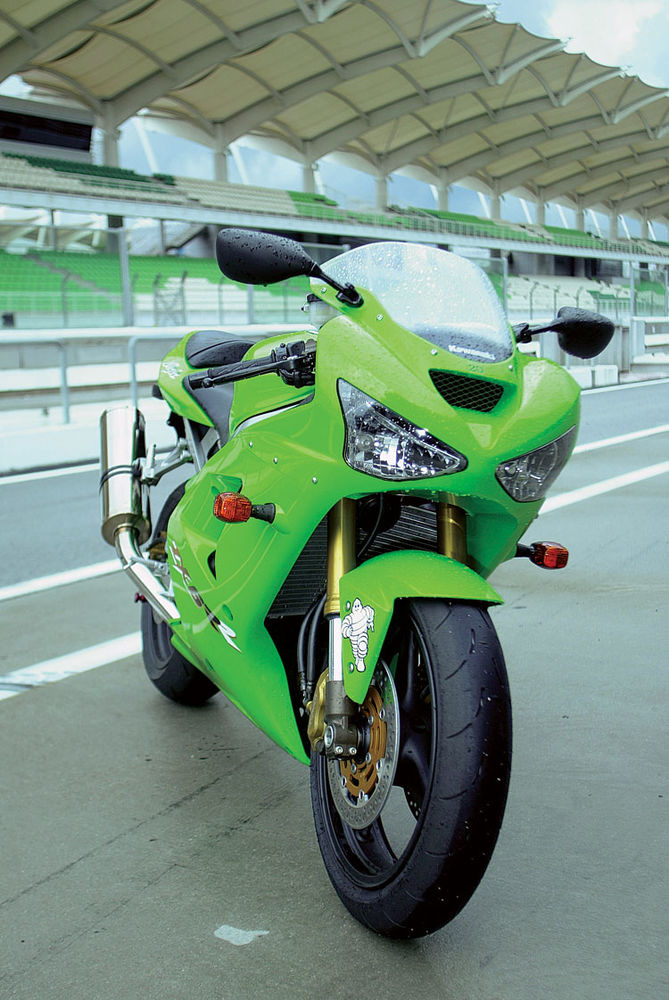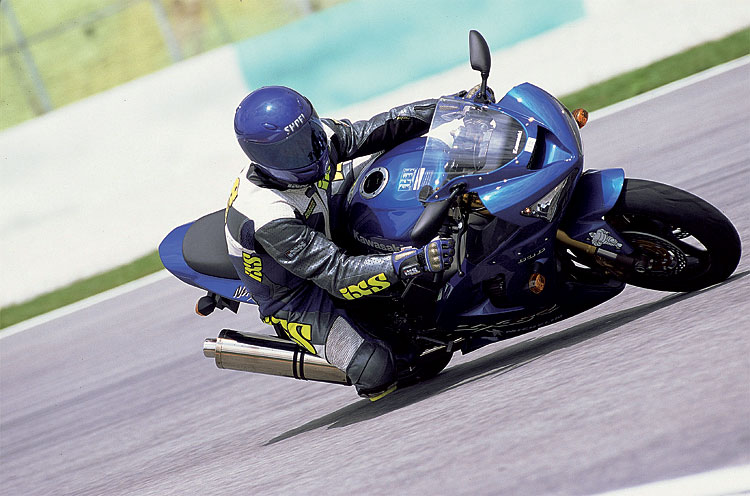Kawasaki Ninja ZX-6R/RR

Team Green wants to recapture the crown for the best 600 Supersport bike. In our opinion, the totally new ZX-6R and ZX-6RR bikes greatly enhance the likelihood of meeting that goal, once RoadRUNNER Motorcycle Cruising & Touring jumped at the chance to ride them at their introduction on the GP-racetrack in Sepang, Malaysia.
Concept & Tranformation
For the model year 2003, Kawasaki is going back to their roots. Their slogan "no compromises" has led to new bikes like the amazing Z1000 and the brand-new range of 600 Ninjas, also called the ZX-6R and ZX-6RR. Starting out in 1995, their first ZX-6R was a real Supersport compared to the more touristic ZX-6. Double-beam aluminum frame, a powerful 100-hp engine, 300-mm disc-brake rotors in the front and wide tires were the goodies which made the new 600 Kawi outstanding in its class.
In 1998, the ZX6-R was totally revised again with a new engine and a new chassis. The power went up to 108 hp, the weight down from 206 kg (458 lb.) to 200 kg (444 lb.). In 2000, another new ZX-6R arrived in the showrooms. A lighter crank, galvanized barrels, higher compression ratio, magnesium covers, two more horses and weight savings made the Ninja even better than before. But overall, Kawasaki kept a wide range of usability in mind to compete with Honda's CBR600F3/F4/F4i - a competition that's bound to heat up. Keep in mind, the new Sixers are made for just one thing: to be fast!

Engine & Transmission
To be competitive in the 600 Supersport class, it was necessary to equip the dohc inline-four engine with a modern fuel injection with large 38-mm throttle bodies. Sub-throttles ensure smooth, linear power characteristics. The higher speed, 32-bit CPU gives more precise engine management. The redesigned cylinder head is ten millimeters shorter, more compact and weighs less. The length of the intake port is shortened by about ten millimeters. Shorter valve guides with smaller diameter and smaller but stronger head bolts (nine instead of ten millimeters) reduce weight. Narrow valve angles of 25 degrees allow the fitting of large valves in a compact, highly efficient combustion chamber. Single springs of oval-shaped wire for the intake valves are lighter and provide enhanced valve control at high rpm. Other changes: new cams, smaller intake tappets, internal oil feeds to the cams, a narrower, shorter pitch cam chain (due to new, smaller cam sprockets), lighter and more rigid crankcases, a more compact oil pan with reduced capacity (now 4 liters), five millimeter shorter skirts for the plated all-aluminum cylinders, and closer ratios for third, fourth, fifth and sixth gear.
Additionally, engine mounts have been moved from the rear of the cylinders to the front. This improves the rigidity of the chassis. The Ram Air duct now runs through the steering head of the frame. The exhaust system is lighter, even though the muffler is made of stainless steel. Also, a lighter and smaller radiator is fitted with a more efficient ring-fan.

Overall, the engine of the 636 revs higher and runs more smoothly than the old one. When the needle of the tach reaches the 7,000-rpm mark, the inline-four turns into a beast. Power output is great, and you can easily rev up to 15,500 rpm. The shift indicator light, adjustable from 12,000 rpm on, will remind you eventually about shifting gears.
The smaller displacement RR (limited edition of 1,000 units worldwide) underscores advantages in the braking zones when shifting down and turning in. Its back torque limiter reduces rear-wheel hopping by allowing the clutch to slip. While turning in, your line is more accurate. Conversely, the 636 riders had us for breakfast on the two long straightaways of Sepang. The bigger displacement engine definitely has more power and needs less shifting to be fast. But for quick cornering, the RR is the better bike.

Chassis & Brakes
To challenge its competitors, the ZX6-R and RR use a new frame, which locates the swingarm pivot further forward for improved action of the rear suspension. On the RR, the location of the pivot is variable (two millimeters up or down) by using other inserts. The longer swingarm has an internal ribbing and a hexagonal shape for higher stiffness. Unlike other brands, Kawasaki doesn't use any top or bottom bracing. That keeps the weight low. Ball bearings for the steering head improve steering response. Absolutely new in this class are the upside-down forks. Like the nitrogen-gas charged rear shocks, they come with adjustments for compression/rebound damping and preload.
On the track, both bikes demonstrated great performance. Even with the standard setup traction is good. Since Sepang is known as a slippery track, we chose the Michelin Pilot Race tires in M2 compound over the standard Pilot Sport. Under hard acceleration out of the tight turns, the bike got a little bit light on the front end and started vibrating slightly with the handlebars. But it never turned into a shake to really worry about. Nevertheless, for race use, the RR is fitted with a steering damper boss.
The new radial-mounted four-piston front brake calipers are another improvement, which makes a difference. Through their stiff design you get more feedback from the brakes to modulate your braking power better. Four independent pads are used for more even wear and improved heat resistance.

Accessories & Arrangements
Besides its sporty Kawasaki MotoGP design - with a low, narrow fairing and a raised, slim rear section (same unit on the new Z1000) - the Sixers contain some other nice features. The instrument panel includes a bar-type LCD tach and a digital display for speed, odometer, tripmeter, cooling fluid temp gauge, and a clock as well as a stopwatch lap timer, which is set by the starter button. The shift indicator light has three settings for off, low, and bright. The hand lever for the front brake can be adjusted in five positions.

To keep the underside of the seat cowl cleaner, an inner fender is mounted to the swingarm. The dual multi-reflector headlight is light and bright. This also counts for the LED taillight, which is very durable. Compared to its predecessor, you can feel the more track-orientated riding position in the sportier handlebar, seat, and footpeg locations, due to Kawasaki's new policy of "no compromises." This is good for high-performance riding; for touring trips the old ZX-6R is the better choice. US and Canadian customers will appreciate the standard single-seat cover, which can be mounted instead of the co-riders upholstery. For Europe, it's an add-on option.

The new Sixers not only look great. They also confirmed the type of performance needed to clamber back to the top the 600 Supersport class. And Kawasaki's decision to continue with a 636-cc displacement for the standard version has to be appreciated for its better driveability in public road use.
Technical Specs
Retail Price $ 7.999/8,399
Warranty One year, unlimited mileage
Maintenance Schedule not yet available
Importer/Distributor Kawasaki Motors Corp., USA, 9950 Jeronimo Road, Irvine, CA 92618, phone (949) 770-0400
Engine
Type 4-cylinder, inline-four, 4-stroke
Cooling liquid-cooled
Valve Arrangement 4 valves per cyl., DOHC, cams chain driven, shim under bucket adjustment
Bore & Stroke 68x43.8/67x42.5 mm
Displacement 636/599 cc
Compression Ratio 12.8:1/13.0:1
Carburetion electronic fuel injection, ø 38 mm
Exhaust Emission Control no (catalytic converter for Europe)
Transmission
Gearbox 6-speed
Clutch multi-plate wet clutch, mechanically operated
Final Drive chain drive
Chassis
Frame double-beam frame, aluminum alloy
Wheelbase 1,400 mm (55.1 in.)
Rake 65.5 degree
Trail 95 mm (3.7 in.)
Front Suspension upside-down-cartridge fork
Stanchion Diameter 41 mm (1.61 in.)
Adjustments spring preload, compression and rebound damping
Travel 120 mm (4.7 in.)
Rear Suspension cast aluminum-alloy swingarm w/single shock
Adjustments spring preload, compression and rebound damping
Travel 135 mm (5.3 in.)
Wheels & Tires
Type cast aluminum-alloy wheels
Front 3.50 x 17
Rear 5.50 x 17
Front Tire 120/65 ZR 17
Rear Tire 180/55 ZR 17
Brakes
Front Brake 2 discs, radial-mounted 4-piston calipers
Diameter 280 mm (11.0 in.)
Rear Brake 1 disc, floating 1-piston caliper
Diameter 220 mm (8.7 in.)
Combining no
Weight & Fuel capacity
Dry-Weight 161 kg (358 lb.)
Fuel Capacity 18 l (4.7 gal.)
Performance
Claimed Horsepower (crank)118/113 hp at 13,000/13,200 rpm
Torque 6.8/6.6 mkp (50.3/48.9 ft.-lbs.) at 11,000/12,000 rpm
Top Speed 260 km/h (162.5 mph)
Acceleration n/a
Fuel Consumption n/a
Fuel Range n/a
Equipment
Full fairing, dashboard w/bar-type LCD tach, digital gauge for speed, odometer, tripmeter, cooling fluid temperature and clock, adjustable shift indicator light (3 settings: off, low, and bright), stopwatch-style lap timer, ignition switch/lock in front of the upper triple clamp, brake lever adjustable (5 positions), side stand, cover for rear seat.
RoadRUNNER Test Diagram
Engine 5/5
Chassis 5/5
Brakes 5/5
Comfort 3/5
Luggage w/accessories 1/5
Equipment 4/5
Design 5/5
Bike for the buck 4/5




